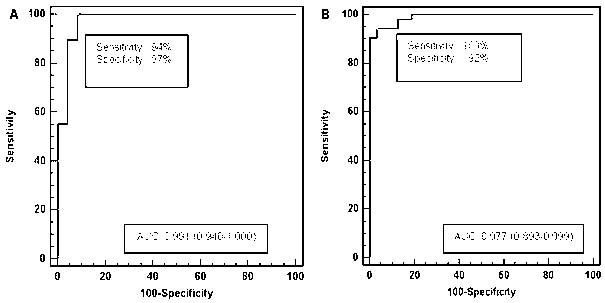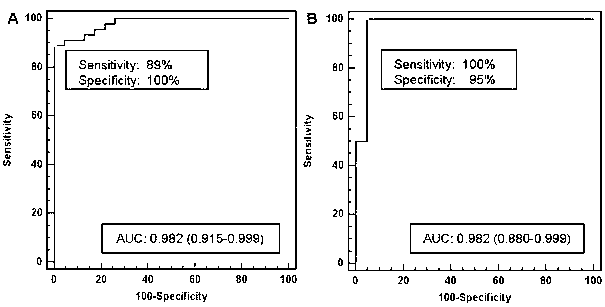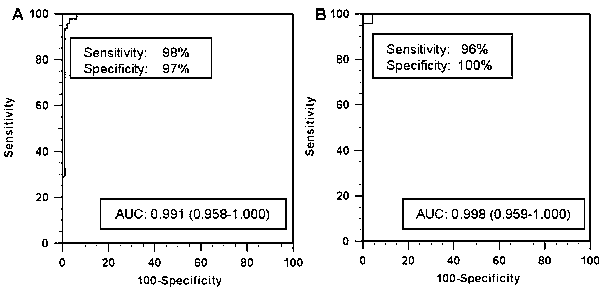MicroRNA marker for identifying subtypes of lung cancer and application of microRNA marker
A technology for lung cancer and purpose, applied in the field of diagnosis of lung cancer subtypes, to achieve the effects of low-cost targeted therapy, broad application prospects, and accurate and reliable results
- Summary
- Abstract
- Description
- Claims
- Application Information
AI Technical Summary
Problems solved by technology
Method used
Image
Examples
Embodiment 1
[0042] Example 1 Screening acquisition and independent verification of microRNA
[0043] The overall experimental plan is as follows:
[0044] By collecting 586 lung cancer tissue or exfoliated cell samples from Zhongshan Hospital between August 2008 and December 2011, each case was reviewed by two experienced lung cancer pathologists, and 586 samples were assigned to one of five groups, among which The cases in each group were independent and did not overlap.
[0045] 1. Discovery group: using laser capture microseparation technology to extract cancer cells from 82 cases (36 cases of AC, 30 cases of SQ and 16 cases of SCLC) from independently frozen tissues for microarray research, and obtained candidate microRNAs for lung cancer typing, And further confirmed its value by quantitative reverse transcription-polymerase chain reaction (RT-PCR).
[0046] 2. Training group: 85 paraffin-embedded lung tissues (29 AC, 24 SQ, and 32 SCLC) were manually isolated to ensure > 75% can...
Embodiment 2
[0120] Example 2 Clinical application of microRNA combination A and combination B
[0121] Two cytopathologists from Shanghai Cancer Hospital and Zhongshan Hospital carried out the lung cancer typing of bronchial brushing cell samples, and directly compared the diagnostic accuracy of cell typing and microRNA combination typing. The results are shown in Table 5. It can be seen from the table that although microRNA combination A (has-miR-29a and has-miR-375) failed to improve the diagnosis of NSCLC compared with cytological diagnosis, it could promote the diagnosis of SCLC; at the same time, the combination of microRNA B (has-miR-205 and has-miR-34a) could more effectively discriminate AC from SQ. The combination of cytology and microRNA detection can greatly improve the diagnosis of lung cancer subtypes, reduce the number of undiagnosed patients by cytology, and help solve the problem of inability to accurately diagnose lung cancer subtypes by brushing cytology. The combinat...
Embodiment 3
[0125] Example 3 Preparation of microRNA chip
[0126] Convert the microRNA (SEQ ID No.2, 3, 4, 7) provided in Table 1 into a complementary sequence, and add a 10-20nt connection sequence at both ends of the sequence according to the GC alignment characteristics of the generated sequence; the core sequence is different, and the connection sequence The sequence is also different. The junction sequence can be randomly generated by the program, and the probes formed by the junction sequence and the core sequence meet the following conditions:
[0127] 1) In the probe sequence, the number of the same nucleotide (A, C, G, T) cannot exceed 50% of the total number of sequences;
[0128] 2) The number of any consecutive A, T or C, G cannot exceed 50% of the total number of sequences;
[0129] 3) G and C content account for 40%-60% of the total number of sequences;
[0130] 4) The probe sequence cannot self-hybridize, that is, the length of the complementary fragment in the probe ...
PUM
 Login to View More
Login to View More Abstract
Description
Claims
Application Information
 Login to View More
Login to View More - R&D
- Intellectual Property
- Life Sciences
- Materials
- Tech Scout
- Unparalleled Data Quality
- Higher Quality Content
- 60% Fewer Hallucinations
Browse by: Latest US Patents, China's latest patents, Technical Efficacy Thesaurus, Application Domain, Technology Topic, Popular Technical Reports.
© 2025 PatSnap. All rights reserved.Legal|Privacy policy|Modern Slavery Act Transparency Statement|Sitemap|About US| Contact US: help@patsnap.com



